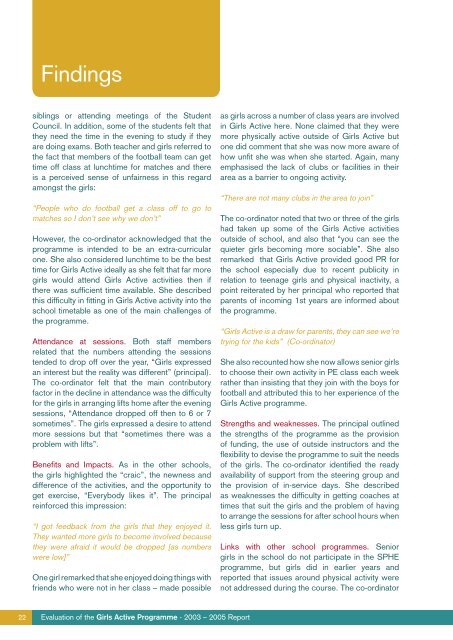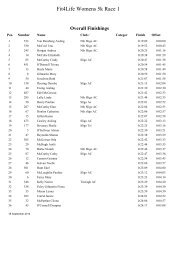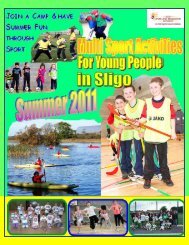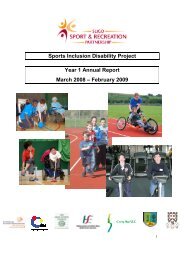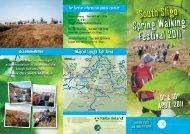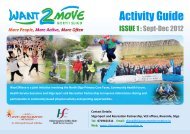Girls Active Programme - Sligo Sport and Recreation Partnership
Girls Active Programme - Sligo Sport and Recreation Partnership
Girls Active Programme - Sligo Sport and Recreation Partnership
You also want an ePaper? Increase the reach of your titles
YUMPU automatically turns print PDFs into web optimized ePapers that Google loves.
Findings<br />
siblings or attending meetings of the Student<br />
Council. In addition, some of the students felt that<br />
they need the time in the evening to study if they<br />
are doing exams. Both teacher <strong>and</strong> girls referred to<br />
the fact that members of the football team can get<br />
time off class at lunchtime for matches <strong>and</strong> there<br />
is a perceived sense of unfairness in this regard<br />
amongst the girls:<br />
“People who do football get a class off to go to<br />
matches so I don’t see why we don’t”<br />
However, the co-ordinator acknowledged that the<br />
programme is intended to be an extra-curricular<br />
one. She also considered lunchtime to be the best<br />
time for <strong>Girls</strong> <strong>Active</strong> ideally as she felt that far more<br />
girls would attend <strong>Girls</strong> <strong>Active</strong> activities then if<br />
there was sufficient time available. She described<br />
this difficulty in fitting in <strong>Girls</strong> <strong>Active</strong> activity into the<br />
school timetable as one of the main challenges of<br />
the programme.<br />
Attendance at sessions. Both staff members<br />
related that the numbers attending the sessions<br />
tended to drop off over the year, “<strong>Girls</strong> expressed<br />
an interest but the reality was different” (principal).<br />
The co-ordinator felt that the main contributory<br />
factor in the decline in attendance was the difficulty<br />
for the girls in arranging lifts home after the evening<br />
sessions, “Attendance dropped off then to 6 or 7<br />
sometimes”. The girls expressed a desire to attend<br />
more sessions but that “sometimes there was a<br />
problem with lifts”.<br />
Benefits <strong>and</strong> Impacts. As in the other schools,<br />
the girls highlighted the “craic”, the newness <strong>and</strong><br />
difference of the activities, <strong>and</strong> the opportunity to<br />
get exercise, “Everybody likes it”. The principal<br />
reinforced this impression:<br />
“I got feedback from the girls that they enjoyed it.<br />
They wanted more girls to become involved because<br />
they were afraid it would be dropped [as numbers<br />
were low]”<br />
One girl remarked that she enjoyed doing things with<br />
friends who were not in her class – made possible<br />
as girls across a number of class years are involved<br />
in <strong>Girls</strong> <strong>Active</strong> here. None claimed that they were<br />
more physically active outside of <strong>Girls</strong> <strong>Active</strong> but<br />
one did comment that she was now more aware of<br />
how unfit she was when she started. Again, many<br />
emphasised the lack of clubs or facilities in their<br />
area as a barrier to ongoing activity.<br />
“There are not many clubs in the area to join”<br />
The co-ordinator noted that two or three of the girls<br />
had taken up some of the <strong>Girls</strong> <strong>Active</strong> activities<br />
outside of school, <strong>and</strong> also that “you can see the<br />
quieter girls becoming more sociable”. She also<br />
remarked that <strong>Girls</strong> <strong>Active</strong> provided good PR for<br />
the school especially due to recent publicity in<br />
relation to teenage girls <strong>and</strong> physical inactivity, a<br />
point reiterated by her principal who reported that<br />
parents of incoming 1st years are informed about<br />
the programme.<br />
“<strong>Girls</strong> <strong>Active</strong> is a draw for parents, they can see we’re<br />
trying for the kids” (Co-ordinator)<br />
She also recounted how she now allows senior girls<br />
to choose their own activity in PE class each week<br />
rather than insisting that they join with the boys for<br />
football <strong>and</strong> attributed this to her experience of the<br />
<strong>Girls</strong> <strong>Active</strong> programme.<br />
Strengths <strong>and</strong> weaknesses. The principal outlined<br />
the strengths of the programme as the provision<br />
of funding, the use of outside instructors <strong>and</strong> the<br />
flexibility to devise the programme to suit the needs<br />
of the girls. The co-ordinator identified the ready<br />
availability of support from the steering group <strong>and</strong><br />
the provision of in-service days. She described<br />
as weaknesses the difficulty in getting coaches at<br />
times that suit the girls <strong>and</strong> the problem of having<br />
to arrange the sessions for after school hours when<br />
less girls turn up.<br />
Links with other school programmes. Senior<br />
girls in the school do not participate in the SPHE<br />
programme, but girls did in earlier years <strong>and</strong><br />
reported that issues around physical activity were<br />
not addressed during the course. The co-ordinator<br />
22<br />
Evaluation of the <strong>Girls</strong> <strong>Active</strong> <strong>Programme</strong> - 2003 – 2005 Report


